New Power MOSFET with Beyond-1D-Limit RSP-BV Trade-Off and Superior Reverse Recovery Characteristics
Abstract
:1. Introduction
2. Device Structure and RSP-BV Trade-Off
3. Body Diode Characteristics
4. Proposed Process Flow
5. Conclusions
Author Contributions
Funding
Conflicts of Interest
References
- Chen, X.; Sin, J.K.O. Optimization of the specific on-resistance of the COOLMOS. IEEE Trans. Electron Devices 2001, 48, 344–348. [Google Scholar] [CrossRef]
- Baliga, B.J. Fundamentals of Power Semiconductor Device; Springer: New York, NY, USA, 2008. [Google Scholar]
- Williams, R.K.; Darwish, M.N.; Blanchard, R.A.; Siemieniec, R.; Rutter, P.; Kawaguchi, Y. The trench power MOSFET: Part I-history, technology, and prospects. IEEE Trans. Electron Devices 2017, 64, 674–691. [Google Scholar] [CrossRef]
- Udrea, F.; Deboy, G.; Fujihira, T. Superjunction power devices, history, development, and future prospects. IEEE Trans. Electron Devices 2017, 64, 713–727. [Google Scholar] [CrossRef]
- Cao, Z.; Duan, B.; Shi, T.; Yuan, S.; Yang, Y. A superjunction U-MOSFET with SIPOS pillar breaking superjunction silicon limit by TCAD simulation study. IEEE Electron Device Lett. 2017, 38, 794–797. [Google Scholar] [CrossRef]
- Park, J.; Lee, J. A 650 V super-junction MOSFET with novel hexagonal structure for superior static performance and high BV resilience to charge imbalance: A TCAD simulation study. IEEE Electron Device Lett. 2017, 38, 111–114. [Google Scholar] [CrossRef]
- Zhang, W.; Zhang, B.; Qiao, M.; Li, Z.; Luo, X.; Li, Z. Optimization and new structure of superjunction with isolator layer. IEEE Trans. Electron Devices 2017, 64, 217–223. [Google Scholar] [CrossRef]
- Shirota, S.; Kaneda, S. New type of varactor diode consisting of multilayer p–n junctions. J. Appl. Phys. 1978, 49, 6012–6019. [Google Scholar] [CrossRef]
- Deboy, G.; Marz, M.; Stengl, J.P.; Strack, H.; Tihanyi, J.; Weber, H. A new generation of high voltage MOSFETs breaks the limit line of silicon. In Proceedings of the 1998 IEEE International Electron Devices Meeting, San Francisco, CA, USA, 6–9 December 1998; pp. 683–685. [Google Scholar]
- Chen, X. Semiconductor Power Devices with Alternating Conductivity Type High-Voltage Breakdown Regions. U.S. Patent 5216675, 1 June 1993. [Google Scholar]
- Coe, D.J. High Voltage Semiconductor Devices. U.S. Patent 4754310, 1 June 1988. [Google Scholar]
- Deboy, G.; Treu, M.; Haeberlen, O.; Neumayr, D. Si, SiC and GaN power devices: An unbiased view on key performance indicators. In Proceedings of the 2016 IEEE International Electron Devices Meeting, San Francisco, CA, USA, 3–7 December 2016; pp. 532–535. [Google Scholar]
- Linder, S. Power Electronics; EPFL Press: Lausanne, Switzerland, 2006. [Google Scholar]
- Zhang, J.; Lai, J.S. A synchronous rectification featured soft switching inverter using CoolMOS. In Proceedings of the 2006 IEEE Applied Power Electronics Conference and Exposition, Dallas, TX, USA, 19–23 March 2006; pp. 810–815. [Google Scholar]
- Conrad, M.; Deconcker, R.W. Avoiding reverse recovery effects in super junction MOSFET based half-bridges. In Proceedings of the 2015 IEEE International Symposium on Power Electronics for Distributed Generation Systems, Aachen, Germany, 22–25 June 2015; pp. 1–5. [Google Scholar]
- Schmitt, M.; Schulze, H.J.; Schlogl, A.; Vosseburger, M.; Willmeroth, A.; Deboy, G. A comparison of electron, proton and helium ion irradiation for the optimization of the CoolMOSTM body-diode. In Proceedings of the 2002 IEEE International Symposium on Power Semiconductor Devices and ICs, Sante Fe, NM, USA, 7 June 2002; pp. 229–232. [Google Scholar]
- Saito, W.; Ono, S.; Yamashita, H. Influence of carrier lifetime control process in superjunction MOSFET characteristics. In Proceedings of the 2014 IEEE International Symposium on Power Semiconductor Devices and ICs, Waikoloa, HI, USA, 15–19 June 2014; pp. 87–90. [Google Scholar]
- Lin, Z.; Hu, S.; Yuan, Q.; Zhou, X.; Tang, F. Low-reverse recovery charge superjunction MOSFET with a p-type Schottky body diode. IEEE Electron Device Lett. 2017, 4, 176–178. [Google Scholar] [CrossRef]
- Cheng, X.; Liu, X.M.; Sin, J.K.O.; Kang, B.W. Improving the CoolMOSTM body-diode switching performance with integrated Schottky contacts. In Proceedings of the 2003 IEEE International Symposium on Power Semiconductor Devices and ICs, Cambridge, UK, 14–17 April 2003; pp. 304–307. [Google Scholar]
- Wei, J.; Zhang, M.; Jiang, H.; Zhou, X.; Li, B.; Chen, K.J. Superjunction MOSFET with dual built-in schottky diodes for fast reverse recovery: A numerical simulation study. IEEE Electron Device Lett. 2019, 40, 1155–1158. [Google Scholar] [CrossRef]
- DeWitt, D.B.; Brown, C.D.; Robertson, S.M. System and Method for Reducing Body Diode Conduction. U.S. Patent 7508175, 24 March 2009. [Google Scholar]
- DeWitt, D.; Brown, C.; Robertson, S. The pinch-off circuit: Reducing noise and component stresses by eliminating body diode conduction in synchronous rectifiers. In Proceedings of the 2007 IEEE Applied Power Electronics Conference and Exposition, Anaheim, CA, USA, 25 Feburary–1 March 2007; pp. 1531–1536. [Google Scholar]
- Xue, P.; Maresca, L.; Riccio, M.; Breglio, G.; Irace, A. Investigation on the self-sustained oscillation of superjunction MOSFET intrinsic diode. IEEE Trans. Electron Devices 2019, 66, 605–612. [Google Scholar] [CrossRef]
- Zhang, M.; Wei, J.; Zhou, X.; Jiang, H.; Li, B.; Chen, K.J. Simulation study of a power MOSFET with built-in channel diode for enhanced reverse recovery performance. IEEE Electron Device Lett. 2019, 1, 79–82. [Google Scholar] [CrossRef]
- Uchida, M.; Horikawa, N.; Tanaka, K.; Takahashi, K.; Kiyosawa, T.; Hayashi, M. Novel SiC power MOSFET with integrated unipolar internal inverse MOS-channel diode. In Proceedings of the 2011 International Electron Devices Meeting, Washington, DC, USA, 5–7 December 2011; pp. 602–605. [Google Scholar]
- TCAD Sentaurus Device Manual; Synopsys Inc.: Mountain View, CA, USA, 2013.
- Cheng, X.; Sin, J.K.O.; Shen, J.; Huai, Y.; Li, R.; Wu, Y.; Kang, B. A general design methodology for the optimal multiple-field-limiting-ring structure using device simulator. IEEE Trans. Electron Devices 2003, 50, 2273–2279. [Google Scholar] [CrossRef]
- Brieger, K.P.; Gerlach, W.; Pelka, J. Blocking capability of planar devices with field limiting rings. Solid-State Electron. 1983, 26, 739–745. [Google Scholar] [CrossRef]
- Ren, Y.; Xu, M.; Zhou, J.; Lee, F.C. Analytical loss model of power MOSFET. IEEE Trans. Power Electron. 2006, 21, 310–319. [Google Scholar]
- Huang, A. Hard Commutation of Power MOSFET. Infineon, Nuebiberg, Germany, Tech. Rep. 2014-03. Available online: https://www.infineon.com/dgdl/Infineon-Power_MOSFET_OptiMOS_FD_200V-250V_hard_diode_commutation-AN-v01_00-EN.pdf?fileId=db3a304344ae06150144b1d2f8250165 (accessed on 12 March 2014).
- Yang, B.; Xu, S.; Korec, J.; Wang, J.; Lopez, O.; Jauregui, D.; Kocon, C.; Herbsommer, J.; Molloy, S.; Daum, G.; et al. NexFET generation 2, new way to power. In Proceedings of the 2011 International Electron Devices Meeting, Washington, DC, USA, 5–7 December 2011; pp. 583–586. [Google Scholar]
- Jiang, H.; Wei, J.; Zhang, B.; Chen, W.; Qiao, M.; Li, Z. Band-to-band tunneling injection insulated-gate bipolar transistor with a soft reverse-recovery built-in diode. IEEE Electron. Device Lett. 2012, 33, 1684–1686. [Google Scholar] [CrossRef]
- Haaf, P. Understanding diode reverse recovery and its effect on switching losses. Fairchild Power Semin. 2007, 23–33. [Google Scholar] [CrossRef]
- Noblecourt, S.; Tasselli, J.; Morancho, F.; Isoird, K.; Austin, P. Design and realization of deep trench superJunction diode for 600V applications. Eur. J. Electr. Eng. 2014, 17, 345–361. [Google Scholar] [CrossRef]
- Park, W.J.; Kim, J.H.; Cho, S.M.; Yoon, S.G.; Suh, S.J.; Yoon, D.H. High aspect ratio via etching conditions for deep trench of silicon. Surface Coat. Technol. 2003, 171, 290–295. [Google Scholar] [CrossRef]
- Yamauchi, S.; Shibata, T.; Nogami, S.; Yamaoka, T.; Hattori, Y.; Yamaguchi, H. 200V super junction MOSFET fabricated by high aspect ratio trench filling. In Proceedings of the 2006 IEEE International Symposium on Power Semiconductor Devices and ICs, Naples, Italy, 4–8 June 2006; pp. 1–4. [Google Scholar]
- Moens, P.; Bogman, F.; Ziad, H.; De Vleeschouwer, H.; Baele, J.; Tack, M.; Loechelt, G.; Grivna, G.; Parsey, J.; Wu, Y.; et al. UltiMOS: A local charge-balanced trench-based 600V super-junction device. In Proceedings of the 2011 IEEE International Symposium on Power Semiconductor Devices and ICs, San Diego, CA, USA, 23–26 May 2011; pp. 304–307. [Google Scholar]
- Tilli, M.; Motooka, T.; Airaksinen, V.; Franssila, S.; Paulasto-Kröckel, M.; Lindroos, V. Handbook of Silicon Based MEMS Materials and Technologies; William Andrew Publishing: Norwich, NY, USA, 2015. [Google Scholar]
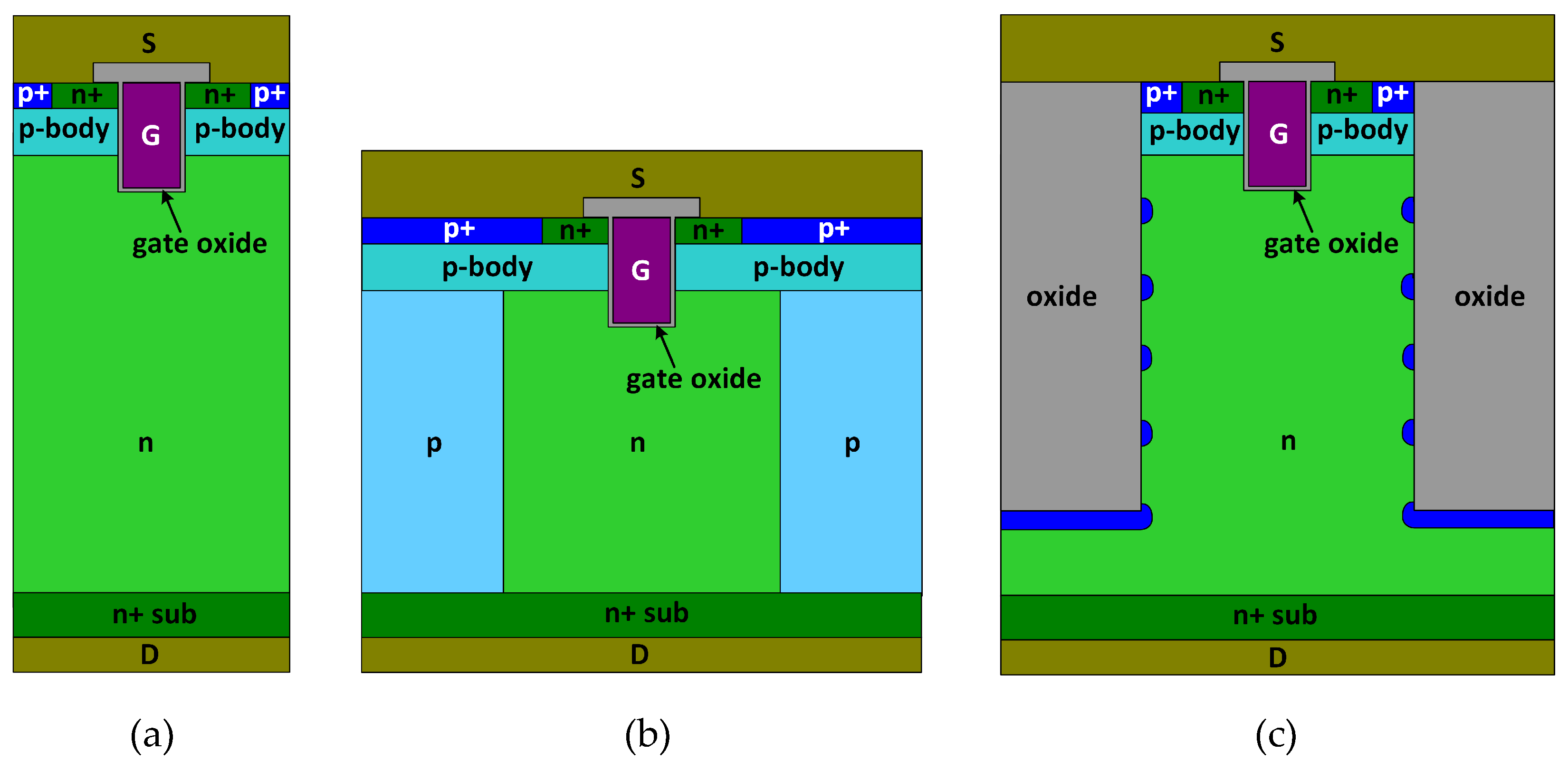
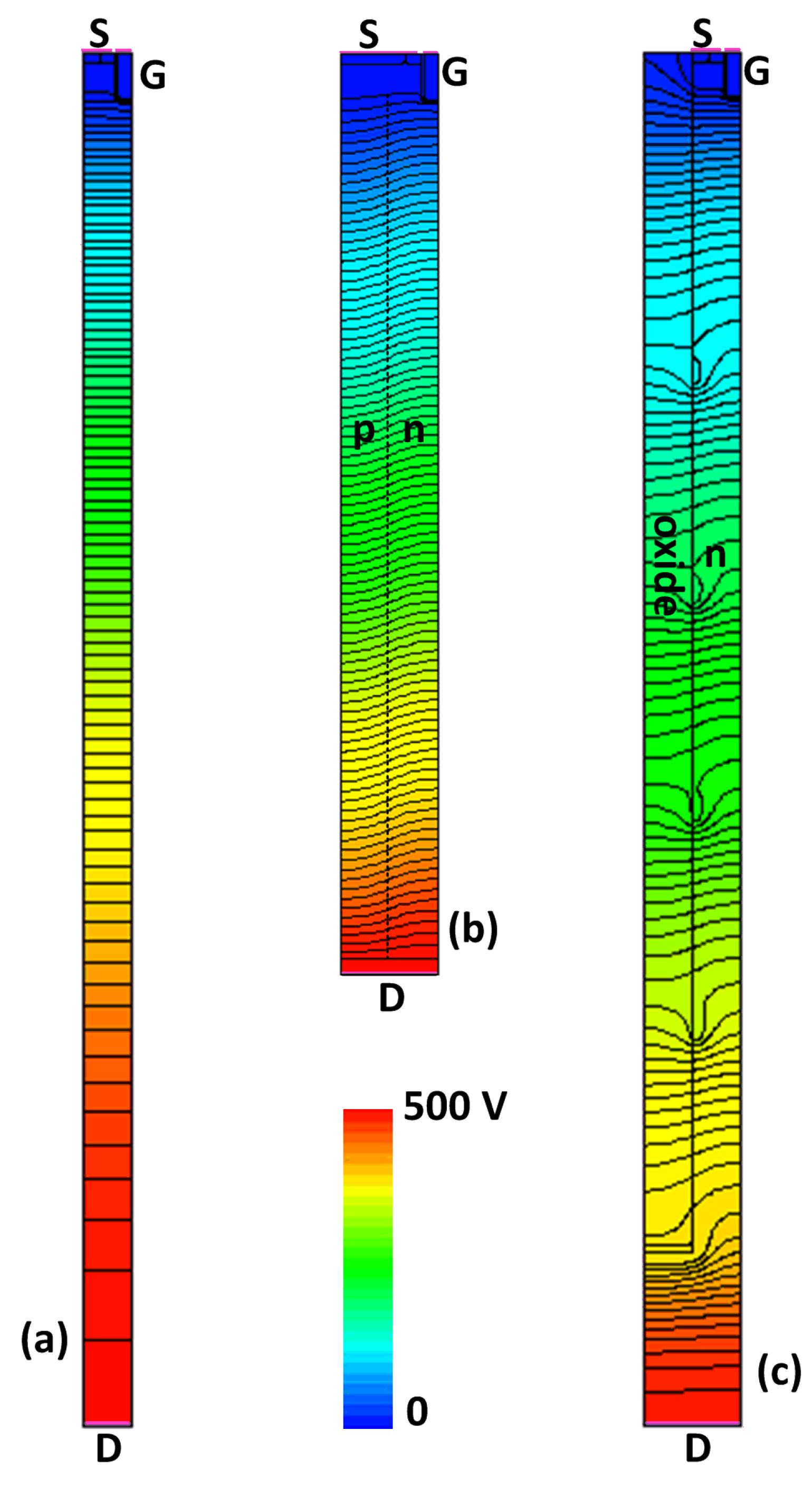
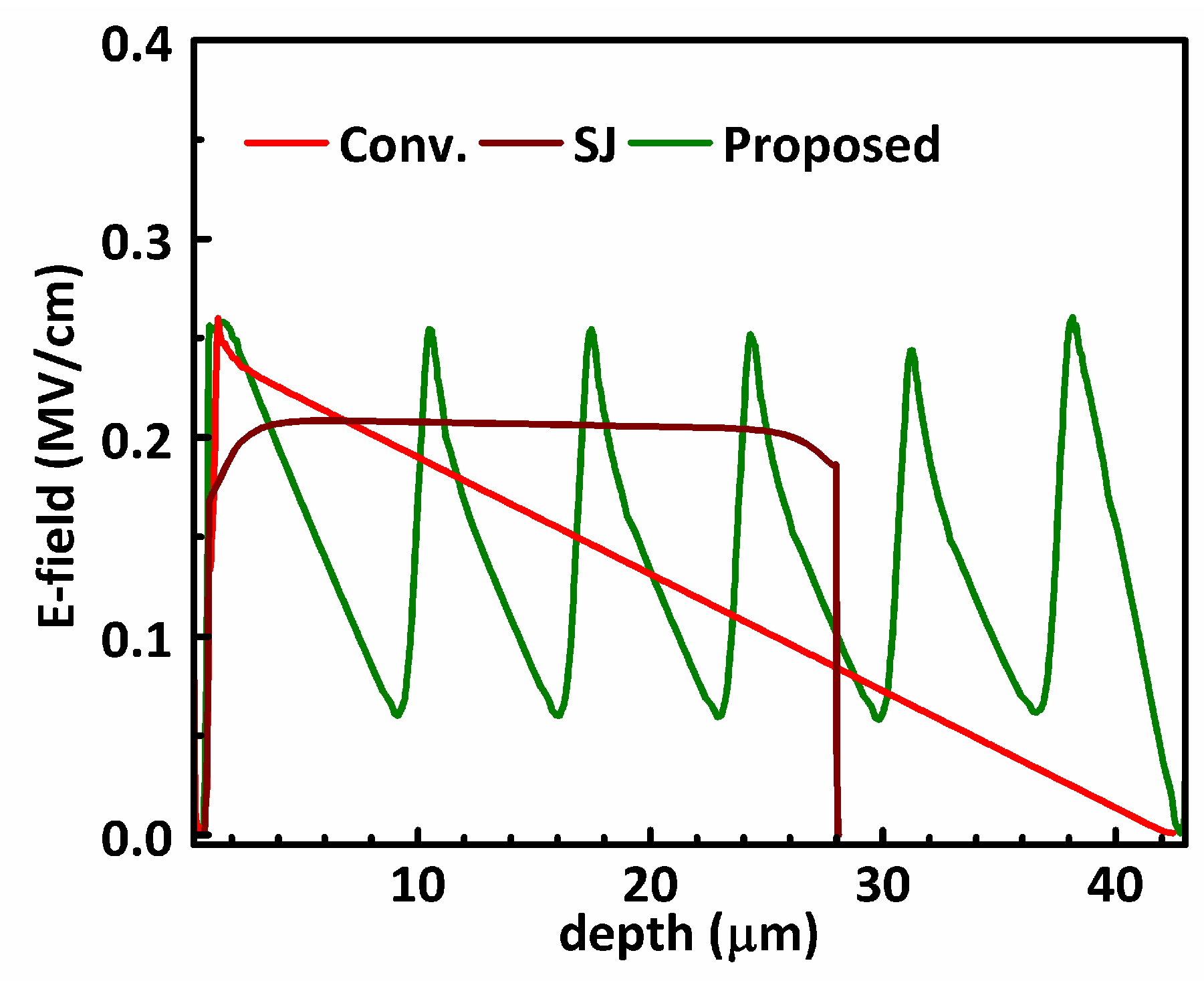
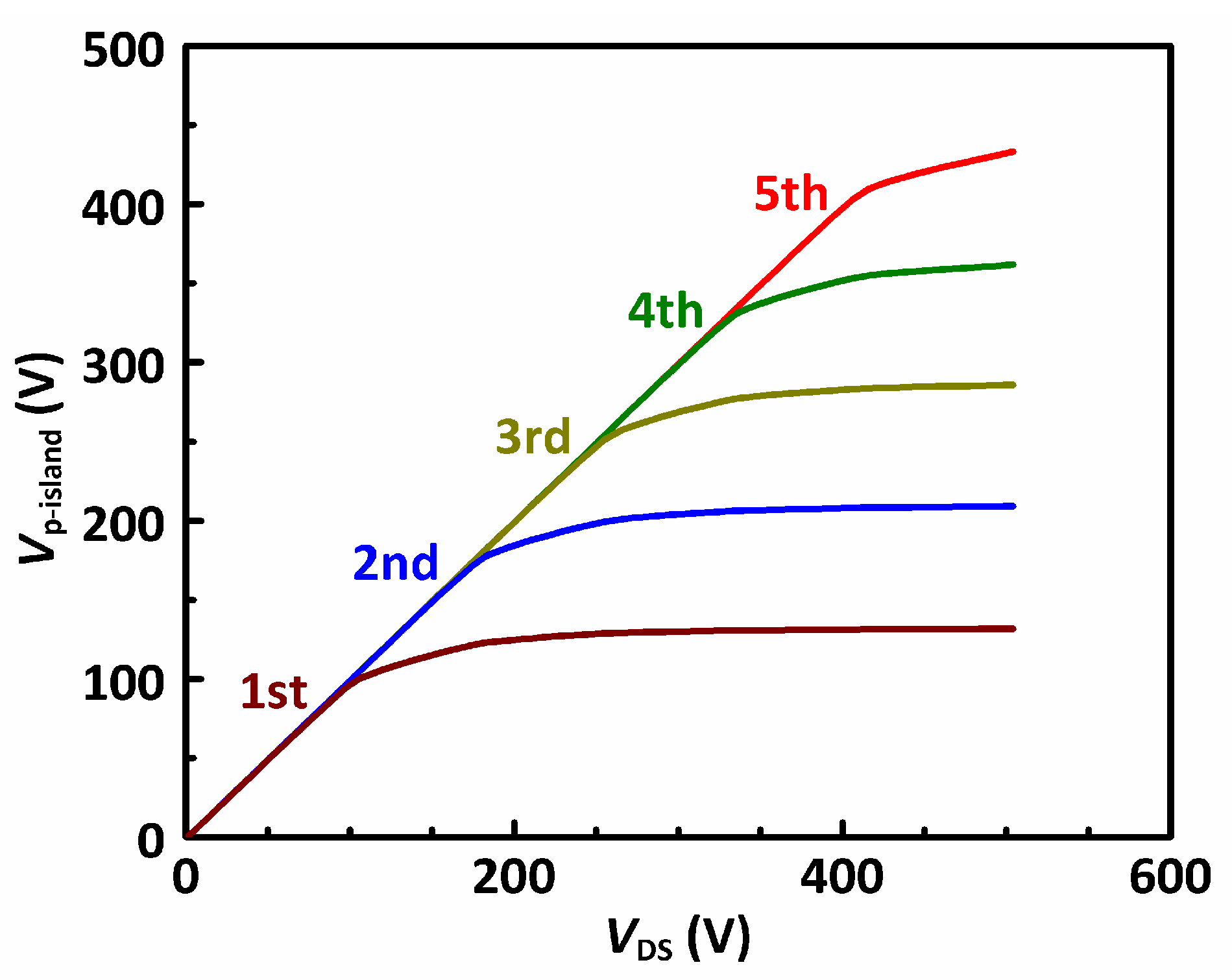
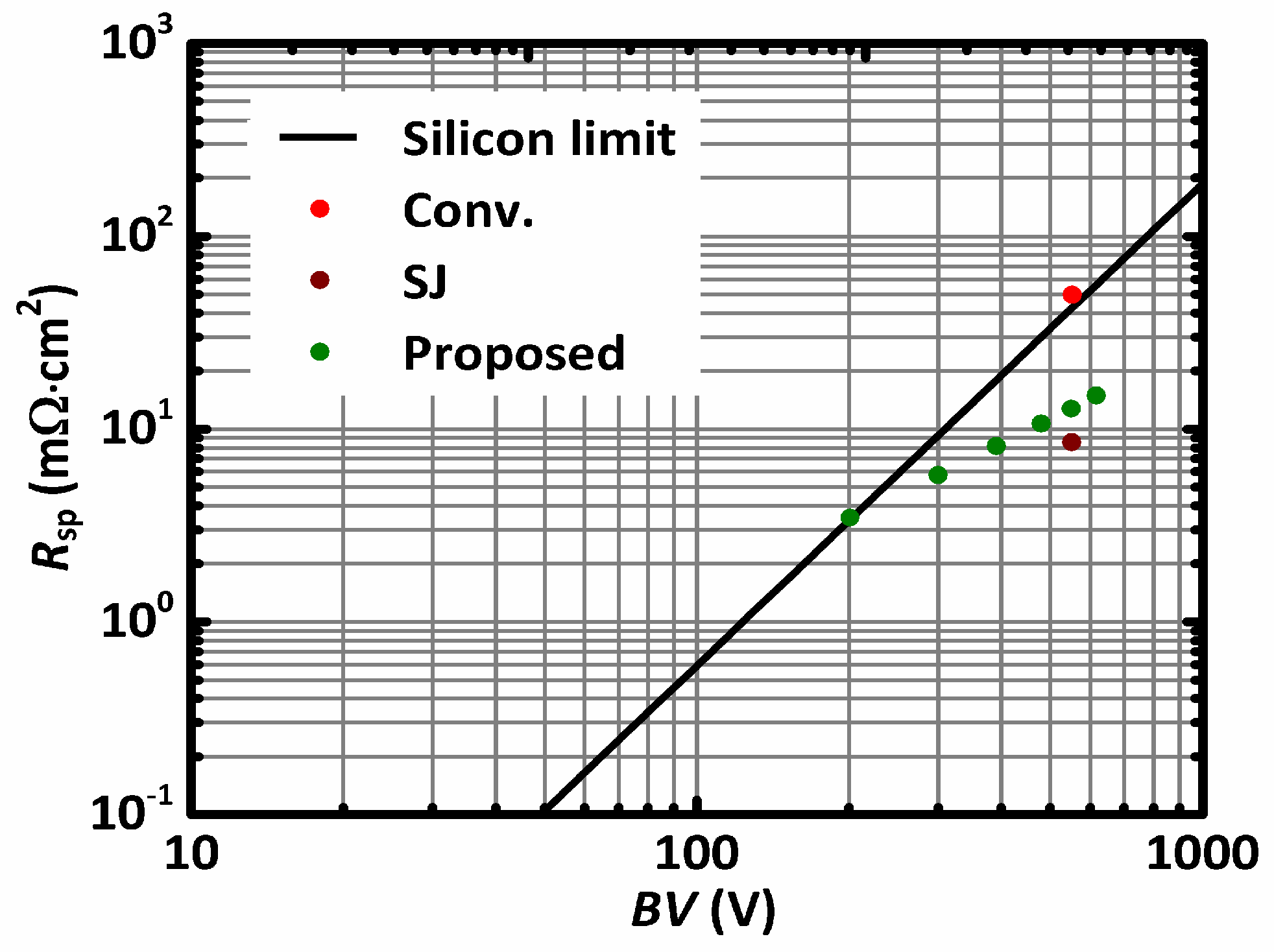
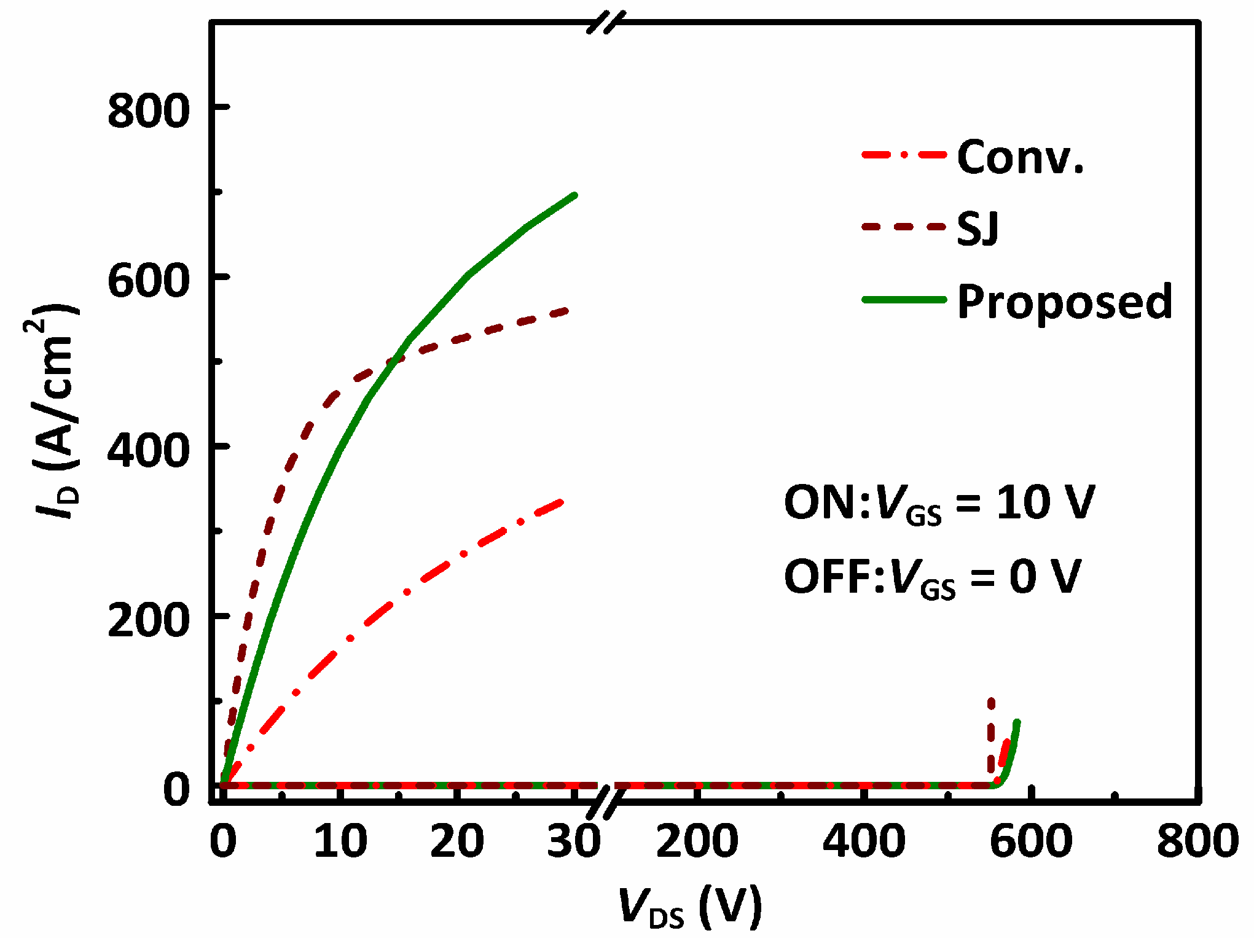


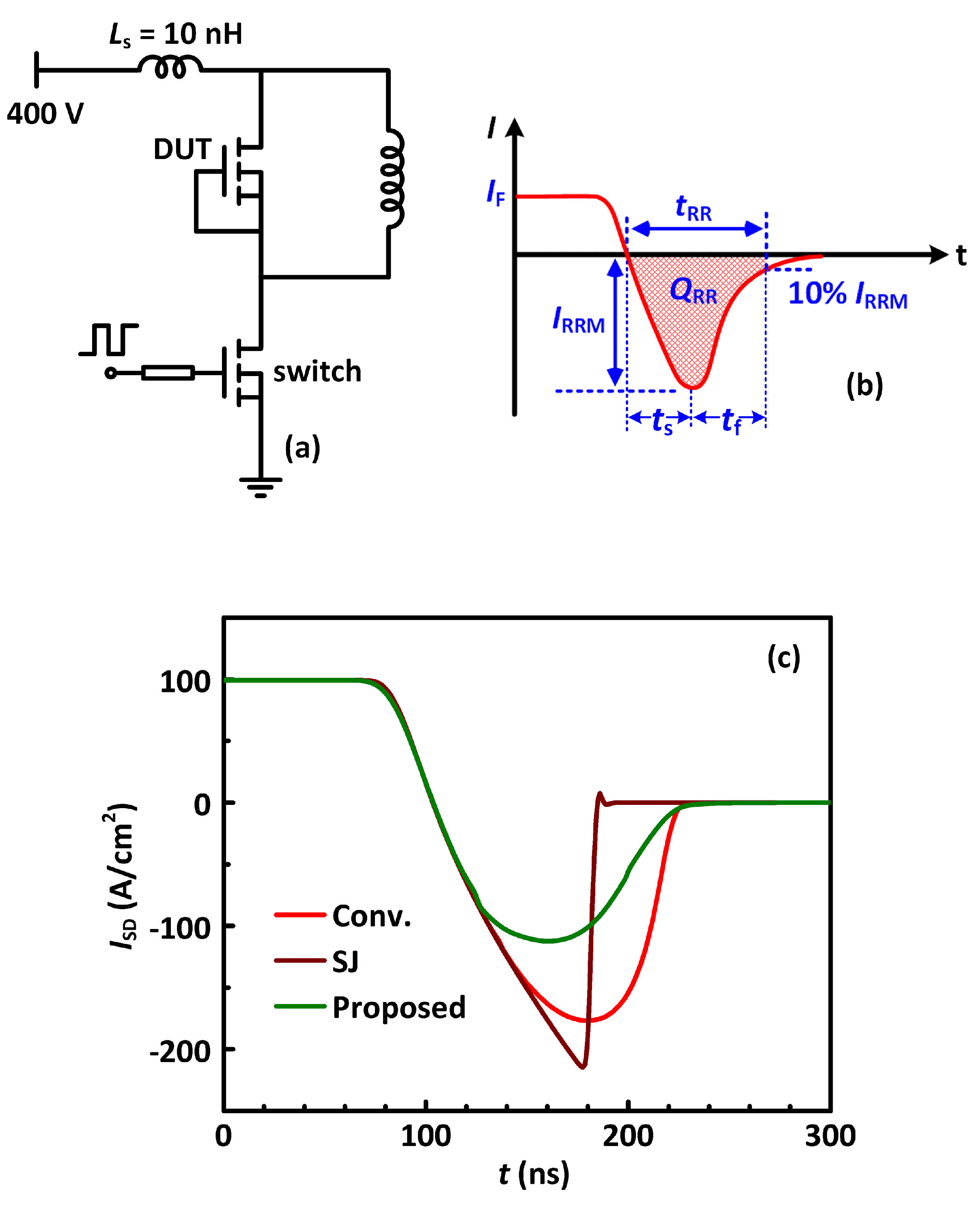
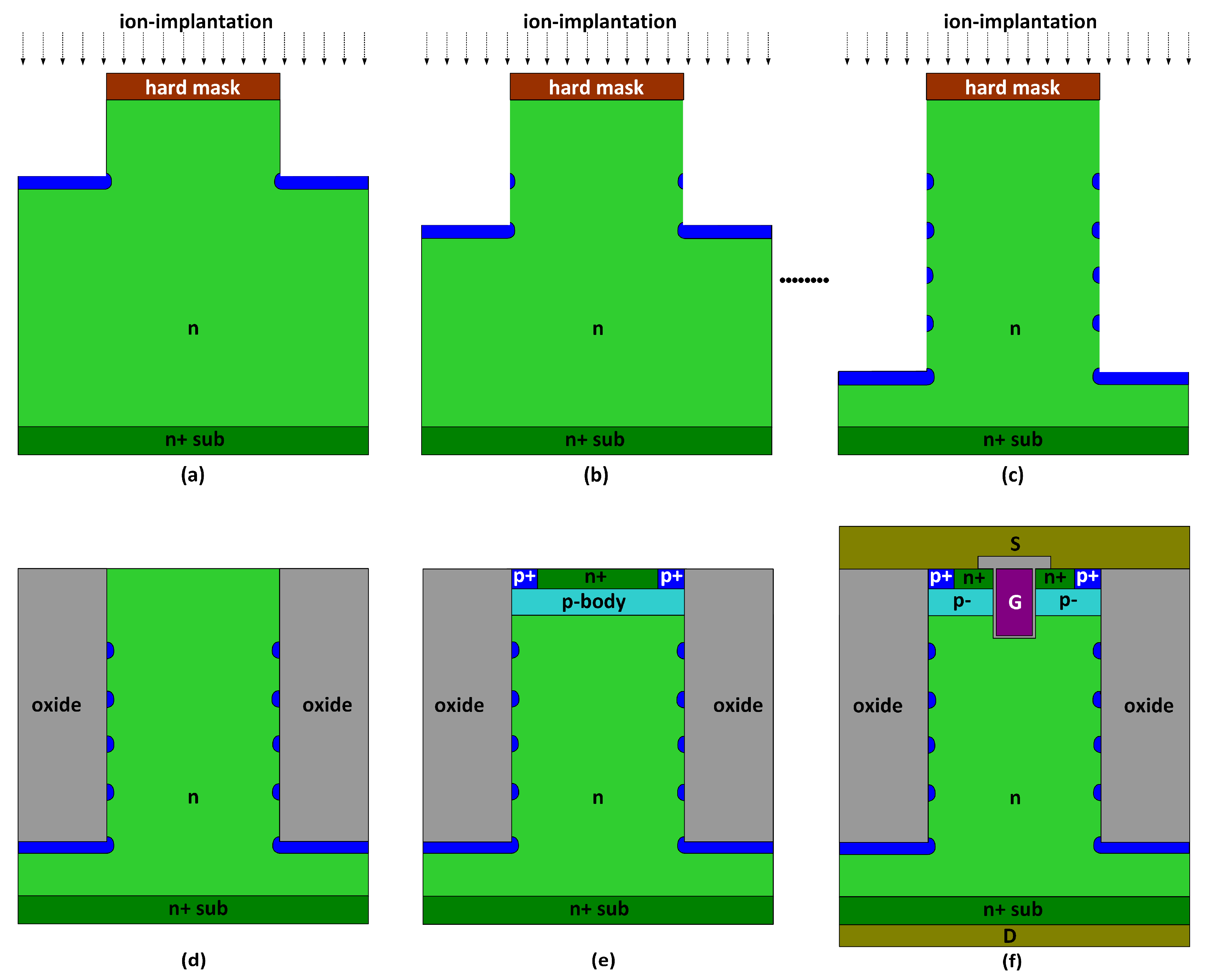
| Parameters | Value | Unit | |
|---|---|---|---|
| Conventional MOSFET | doping of n-drift | 3.8 × 1014 | cm−3 |
| thickness of n-drift | 42 | µm | |
| cell pitch | 3 | µm | |
| Superjunction MOSFET | doping of n/p-pillar | 4 × 1015 | cm−3 |
| thickness of n/p-pillar | 28 | µm | |
| pitch of n/p-pillar | 3 | µm | |
| Proposed MOSFET | doping of n-drift | 4 × 1015 | cm−3 |
| thickness of n-drift | 42 | µm | |
| pitch of n-drift | 3 | µm | |
| pitch of trench oxide | 3 | µm |
| Conv. | SJ. | Proposed | Unit | |
|---|---|---|---|---|
| RSP | 49.80 | 8.52 | 12.74 | mΩ·cm2 |
| BV | 550 | 550 | 550 | V |
| VRCa | 0.79 | 0.78 | 0.85 | V |
| tRR | 116 | 80 | 114 | ns |
| ts | 74 | 75 | 60 | ns |
| tf | 42 | 5 | 54 | ns |
| S (tf/ts) | 0.57 | 0.07 | 0.90 | - |
| QRR | 14.30 | 9.85 | 8.88 | µC/cm2 |
| IRRM | 177 | 216 | 114 | A/cm2 |
© 2020 by the authors. Licensee MDPI, Basel, Switzerland. This article is an open access article distributed under the terms and conditions of the Creative Commons Attribution (CC BY) license (http://creativecommons.org/licenses/by/4.0/).
Share and Cite
Zhang, M.; Li, B.; Wei, J. New Power MOSFET with Beyond-1D-Limit RSP-BV Trade-Off and Superior Reverse Recovery Characteristics. Materials 2020, 13, 2581. https://doi.org/10.3390/ma13112581
Zhang M, Li B, Wei J. New Power MOSFET with Beyond-1D-Limit RSP-BV Trade-Off and Superior Reverse Recovery Characteristics. Materials. 2020; 13(11):2581. https://doi.org/10.3390/ma13112581
Chicago/Turabian StyleZhang, Meng, Baikui Li, and Jin Wei. 2020. "New Power MOSFET with Beyond-1D-Limit RSP-BV Trade-Off and Superior Reverse Recovery Characteristics" Materials 13, no. 11: 2581. https://doi.org/10.3390/ma13112581
APA StyleZhang, M., Li, B., & Wei, J. (2020). New Power MOSFET with Beyond-1D-Limit RSP-BV Trade-Off and Superior Reverse Recovery Characteristics. Materials, 13(11), 2581. https://doi.org/10.3390/ma13112581




